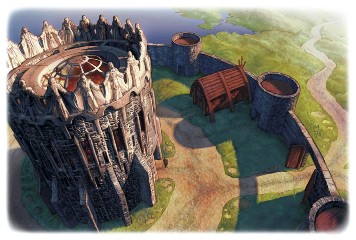![]()
 Sometimes the best monsters aren’t monsters but people. Think cults, corrupt courts or government, mafia, drow cities, the Cult of Elder Elemental Eye and the Zhentarim from the Forgotten Realms, to name a few. These are all power groups: intelligent and widespread organizations, factions and networks.
Sometimes the best monsters aren’t monsters but people. Think cults, corrupt courts or government, mafia, drow cities, the Cult of Elder Elemental Eye and the Zhentarim from the Forgotten Realms, to name a few. These are all power groups: intelligent and widespread organizations, factions and networks.
What human and humanoid opponents and power groups offer in particular is a great combination of both shared and different goals (from simple to complex), intelligence, and an ever-present injection of mystery and political intrigue in your campaign. There’s often a host of raw and classic human motives at work – individually, small scale and large scale.
From a creative aspect, a brand new power group can really be a surprise, because their presence and motives might not be immediately clear or known at all. And maybe their agenda even changes.
Plus the inclusion of more civilized people and humanoids makes more difficult choices for the PCs. Killing civilized peoples is generally a bad idea, and morally questionable in the least, if not black-and-white evil in D&D. Never mind doing so in public places, like urban settings, where murder is likely illegal and at least getting you thrown in the dungeons if not facing the death penalty yourselves.
A lot of fantasy and sci-fi’s best villains and monsters are people who are part of greater power groups and networks, with innocents getting caught in their machinations. Once again, true monsters in the sense that they’ll go to any lengths, and yet possessed of intelligence and thus lots of social connections and dangerous, powerful or otherwise influential friends.
As a PC, sure, you can kill one but… it’s not like killing a few carrion crawlers or even orcs and moving on. Killing people, and especially important people with rank or otherwise part of power groups or networks creates a whole host of potential new threats and dangers to not only the PCs, but other people in the world – from innocents to people the PCs have grown to know, like and care about. Other adventurers and friends they’ve met and made on the way, employers, contacts, and even family may become embroiled in these intelligent adversaries’ foul schemes, taking vengeance and blackmail to whole new levels. Ask yourself: is it worth killing this humanoid creature – this person? Remember, it’s a whole different animal you’re dealing with now!
As a DM, maybe that’s what you want to look for as you play, more so than at character creation: who and what the PCs end up caring most about, either as a natural part of their backstory or background selections, or as an organic meeting or event during actual play. Intelligent enemies and networks wouldn’t often hesitate to use that knowledge to their advantage, in a variety of combat and non-combat situations. Rare is the PC who isn’t engaged by that sort of truly monstrous and heinous behavior by supposedly “civilized” opposition – there are some lines power groups cross that really bring the PCs’ hatred to bear!
Other great ways to include or create power groups’ influence and schemes over an entire tier of play or campaign include starting with an epic tier solo, such as a deity, primordial, or something similar. Think your way backwards into earlier levels and tiers, and look for existing cultist “monsters” or create new ones by reflavoring existing ones. Some powerful monster entries already describe an entire thematic suite of monsters and enemies related to a power group and/or an ultimate master, such as found in the Plane Above and Plane Below sourcebooks.
Such an approach makes for tremendous inspiration in planning an engaging, sweeping campaign arc that includes a few defining events and defining, connected adversaries. For extra fun and intrigue, include two or more extremely active power groups – sometimes collaborating, sometimes competing!
[…] t-12. Fight the Power… Groups! […]